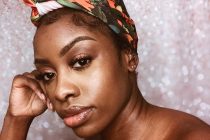Managing three fashion brands with the production in West Africa from Sweden on a daily basis? Malmö-native Victoria Pettersson Henry proves nothing is impossible. Through her street fashion label HENRY RUDE, jewellery line VICTORIA HENRY and interior design project NATIVE LIVING, she provides an outlet for her never ending creative flow. KRULL chatted with Victoria about her fashion vision in the midst of preparations for the release of Henry Rude’s newest collection- this time including a children’s line, Baby Rude.
Tell us your story – how did your adventure with fashion start and how did you decide to start your own business with production based in Ghana & Burkina Faso?
I’ve always been interested in fashion and all kinds of creative fields. I started making jewellery at the age of 16, and also sewed garments from vintage textiles that I then sold in my mother’s store. When I went to Jamaica on a family trip in 2012, I stumbled upon a West African fabric and fell in love. I knew I had to do something with this, and ended up sewing a pair of shorts for myself. The idea of making a full collection grew. Later when my dad travelled to Ghana in 2014, I went with him and decided to find some local tailors to work with and produced my first African-made capsule collection! I have continued to travel there twice a year ever since, and still work with some of the tailors I met the first time. I was also dating a guy from Burkina Faso and when we traveled there I was so inspired by the woven textiles and handicrafts that are made there!
You own three brands at the moment: Henry Rude, presenting street fashion with the use of African printed textiles; Victoria Henry with your handmade jewellery and clothing, and Native Living – artisan made interior. Why did you develop these three separate concepts and what ideas do you want to convey with each one of them?
I think it’s mostly about my difficulty to stick to one concept at a time. When I’m in West Africa I always get overwhelmed with the inspiration and I just feel like I have to express it!
Henry Rude is more raw and quirky – typical streetwear where I let the prints & colours speak for themselves. I also just launched a children’s wear line called Baby Rude as the prints work perfectly for children.
Victoria Henry started as a jewellery brand, but has developed into offering clothing & accessories as well. I like to explore more natural, down to earth textiles such as linen & handwoven cotton with this brand.
I also started bringing back lots of interior pieces and textiles from my trips and when the collection got too big I decided to sell these on a separate platform, which I call Native Living. It’s my new project which I’m launching this summer and I’m so excited to offer these beautiful artisanal goods to people who appreciate the beauty and history of something handmade.
What are the practicalities of having a brand with production established in West Africa – how is your design and production process, how do you communicate with the production when you are in Sweden, etc?
Right now my main problem is actually producing while not on spot. I produce mostly when I’m there, because if I’m not, things don’t go as planned. I love working with tailors and artisans on a grass roots level, but they’re used to producing other quantities, and for another crowd who might not have the same ideas on details and continuity as it takes to sell something over here.
I’m trying to find a solution where I don’t have to be present and I’m noticing that we understand each other better for each day. Some pieces, like jewellery and accessories, are easier to produce while communicating through phone calls and sending pictures through Whatsapp. But with the garments I usually don’t have a clear view of how the pieces will look until I’m there and find the textiles I want to work with. It’s been a lot of experimenting, trial and error.
What are the challenges and the best parts of collaborating with your West African craftsmen and production?
Having to follow a continuity has been difficult as the tailors are used to sewing each garment after their customers measurements, not specific sizes. Also deadlines and time limits, because, well… ”African time”☺ But all of this is also so characteristic, and I love it when we work together on pieces, mixing their skills and ideas with mine. The best part is also that I can tell my customers who made each and every piece and that they were made under decent working conditions, which is a lot more than many high street brands can do.
The use of African textiles and especially Dutch wax print is increasingly popular both within the diaspora and also on the high street- with both independent brands and fashion giants sourcing the traditional prints in different ways. That raises questions about in what way, how and by whom these types of traditional prints should be used. What is your position in this question?
Obviously I love the prints and the history they carry is very important. I think it’s amazing that people are starting to appreciate these textiles more and more – especially here in Scandinavia where the majority wears black and grey… I think designers should be allowed to be inspired by, and use these kind of textiles, but it’s also really important to know where they come from and what they mean. The brands have to communicate this to the consumers, so that they may also know what they represent and support with their style. Credit where credit is due, as they say…
You are based in Malmö, probably the most diversified and multicultural Swedish city. Does it inspire you in some way?
Definitely! We have a strong club scene going on and a lot of my friends who are DJ’s are into West African beats and club music which I also love and get inspired by. I love mixing cultures and ideas, and I think that can be seen especially in my Henry Rude collections where the silhouettes are quite classic and simple, whereas the textiles are wild and playful.
You have Jamaican and Swedish roots – did your experience as a young Afro-Swede form your entrepreneurial spirit in some way, and how did your travels to and settling a business in Ghana/Burkina Faso influence your personal journey as a citizen of the world?
I don’t know if it has to do with my ethnic roots, but maybe more just the fact that I have creative and entrepreneurial parents who travelled a lot themselves. It’s always been natural for me to express my ideas and inspirations, and to travel as much as possible. Before traveling to West Africa it was never really my dream destination, and I would’ve never guessed how much it would come to inspire me! It has opened my eyes and opened new doors, which I am truly thankful for. A lot of friends have said the same things after seeing my photos and videos – they’d never thought of going there before, but several have gone there now out of interest of the culture(s).
You recently posted a bit on your views on fashion images and representation within the modelling world while quoting Benetton as an inspiration for your look book shoots. What other fashion brands inspire you and what do you think should be seen more in fashion imagery? How do you want to represent Henry Rude and what do you think about while casting your models, preparing the imagery etc?
Basically all brands that have a transparent production, and work on a small scale or grass roots level inspire me a lot! Mixed Grill Banjul, The Kind Label and Brother Vellies are some amazing brands that produce in Africa and whose social media feeds I always find inspiring. I want Henry Rude to represent real people, just like my customers. I also like to use a majority of people with other/mixed ethnicities as I feel like there isn’t enough representation in today’s media. Strong characters and personalities is something I look for when casting models, but I also just love having a fun and relaxed vibe on the photo shoots and usually end up using friends and acquaintances as models!
What are you plans and dreams for the near and long-term future?
A big dream has always been to open a little store, and I’ve just signed a contract on a little shop/studio space which I will share with two creative friends. It’s located at S:t Knut, the best neighbourhood of Malmö with several nice cafés, restaurants & small shops…
Right now I’d like to focus more on my brands and have them blossom and develop as much as possible. For the future I’d also love to expand my production to other countries, and collaborating with more artisans with new skills and materials for my collections. The inspiration flow never stops…
words WERONIKA PÉREZ BORJAS
photos ÅSA HALEBY, JOHAN NILSSON, MELINA REID
retouch ÅSA T ERIKSSON
Victoria’s websites: http://www.henryrude.com/
https://www.victoria-henry.com/
http://nativeliving.tictail.com/







